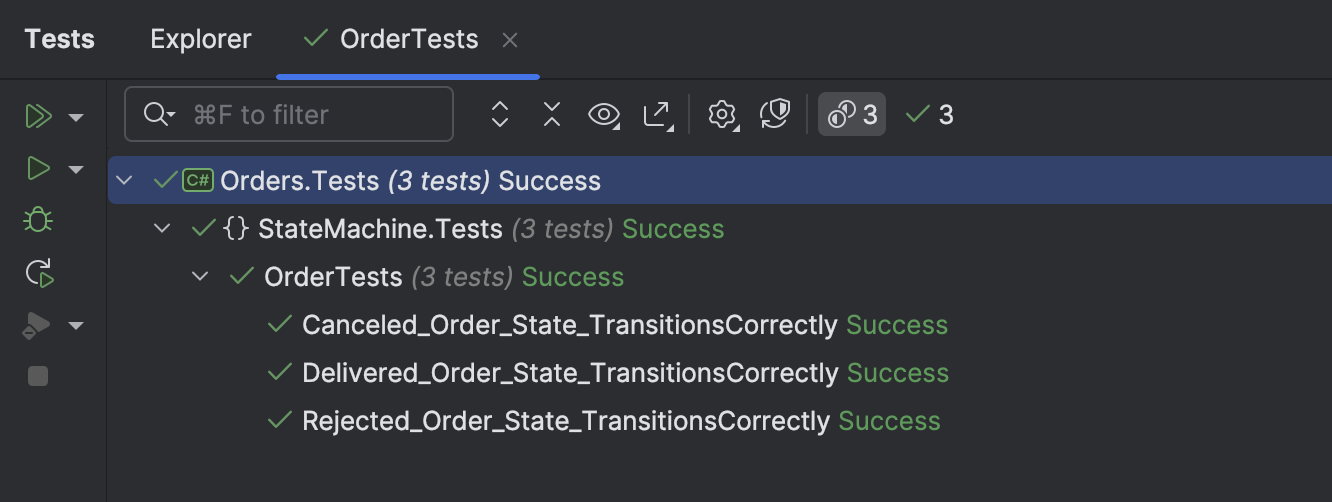Using State Machines In .NET - Part 4 - Using Multiple Triggers
[C#, .NET, Stateless, StarLibrary]
This is Part 4 of a series on using State Machines to express complex logic.
- Using State Machines In .NET - Part 1 - Introduction
- Using State Machines In .NET - Part 2 - Basic Usage
- Using State Machines In .NET - Part 3 - Setting Initial State
- Using State Machines In .NET - Part 4 - Using Multiple Triggers (This Post)
- Using State Machines In .NET - Part 5 - Using Complex & Nested States
- Using State Machines In .NET - Part 6 - Firing Events On State Change
- Using State Machines In .NET - Part 7 - Conditional State Transitions
- Using State Machines In .NET - Part 8 - Firing Events Before State Change
- Using State Machines In .NET - Part 9 - Calling Asynchronous Methods
- Using State Machines In .NET - Part 10 - Generating State Diagrams
- Using State Machines In .NET - Part 11 - Logic Based On How A State Was Transitioned
- Using State Machines In .NET - Part 12 - State Activation & Entry
In our last two posts, we looked at configuring a state machine and setting its initial state.
In both examples, we used a single trigger to cycle through the traffic light states.
But usually, you will have a more complex problem where there are multiple triggers that you use to transition states.
Take, for example, an Order.
- An Order starts off as
Incomplete - Customers can complete the order by transitioning to
OrderComplete. - When it is complete, customers will get a prompt to pay.
- At this point, they can cancel, at which point it is
Canceled, or they can make payment, at which point it isOrdered. - It can then be dispatched, at which point it transitions to
Dispatched. - The order can then be delivered, after which it is
Delivered. - If the customer rejects it, it is
Rejected.
The state diagram is like this:

We can implement our Order class as follows:
using Stateless;
using Stateless.Graph;
namespace Orders;
public sealed class Order
{
private readonly StateMachine<Status, Trigger> _stateMachine;
public string Graph => UmlDotGraph.Format(_stateMachine.GetInfo());
public Status CurrentStatus => _stateMachine.State;
public Order()
{
// Create the state machine, and set the initial state as Incomplete
_stateMachine = new StateMachine<Status, Trigger>(Status.Incomplete);
//
// Configure state machine
//
_stateMachine.Configure(Status.Incomplete)
.Permit(Trigger.CompleteOrder, Status.OrderCompleted);
_stateMachine.Configure(Status.OrderCompleted)
.Permit(Trigger.Pay, Status.OrderPaid)
.Permit(Trigger.Cancel, Status.Canceled);
_stateMachine.Configure(Status.OrderPaid)
.Permit(Trigger.Dispatch, Status.Dispatched);
_stateMachine.Configure(Status.Dispatched)
.Permit(Trigger.Deliver, Status.Delivered)
.Permit(Trigger.Reject, Status.Rejected);
}
public void CompleteOrder()
{
_stateMachine.Fire(Trigger.CompleteOrder);
}
public void PayOrder()
{
_stateMachine.Fire(Trigger.Pay);
}
public void CancelOrder()
{
_stateMachine.Fire(Trigger.Cancel);
}
public void DispatchedOrder()
{
_stateMachine.Fire(Trigger.Dispatch);
}
public void DeliverOrder()
{
_stateMachine.Fire(Trigger.Deliver);
}
public void RejectOrder()
{
_stateMachine.Fire(Trigger.Reject);
}
}
Of interest is here we have implemented methods that we use to transition our state.
We then create tests to verify everything is functioning correctly.
public class OrderTests
{
[Fact]
public void Delivered_Order_State_TransitionsCorrectly()
{
var order = new Order();
order.CurrentStatus.Should().Be(Status.Incomplete);
order.CompleteOrder();
order.CurrentStatus.Should().Be(Status.OrderCompleted);
order.PayOrder();
order.CurrentStatus.Should().Be(Status.OrderPaid);
order.DispatchOrder();
order.CurrentStatus.Should().Be(Status.Dispatched);
order.DeliverOrder();
order.CurrentStatus.Should().Be(Status.Delivered);
}
[Fact]
public void Rejected_Order_State_TransitionsCorrectly()
{
var order = new Order();
order.CurrentStatus.Should().Be(Status.Incomplete);
order.CompleteOrder();
order.CurrentStatus.Should().Be(Status.OrderCompleted);
order.PayOrder();
order.CurrentStatus.Should().Be(Status.OrderPaid);
order.DispatchOrder();
order.CurrentStatus.Should().Be(Status.Dispatched);
order.RejectOrder();
order.CurrentStatus.Should().Be(Status.Rejected);
}
[Fact]
public void Canceled_Order_State_TransitionsCorrectly()
{
var order = new Order();
order.CurrentStatus.Should().Be(Status.Incomplete);
order.CompleteOrder();
order.CurrentStatus.Should().Be(Status.OrderCompleted);
order.CancelOrder();
order.CurrentStatus.Should().Be(Status.Canceled);
}
}
Our tests pass, as expected.

Now, suppose a developer unfamiliar with the flow attempts to Deliver an order immediately after creation.
var order = new Order();
order.CurrentStatus.Should().Be(Status.Incomplete);
order.DeliverOrder();
We get the following:
System.InvalidOperationException
No valid leaving transitions are permitted from state 'Incomplete' for trigger 'Deliver'. Consider ignoring the trigger.
We get an InvalidOperationException because to transition from Incomplete to Delivered is not possible.
We can test for this:
[Fact]
public void New_Order_Should_Not_Be_Deliverable()
{
var order = new Order();
order.CurrentStatus.Should().Be(Status.Incomplete);
var ex = Record.Exception(() => order.DeliverOrder());
ex.Should().BeOfType<InvalidOperationException>();
}
We can similarly check for the other transitions:
[Fact]
public void New_Order_Should_Not_Be_Payable()
{
var order = new Order();
order.CurrentStatus.Should().Be(Status.Incomplete);
var ex = Record.Exception(() => order.PayOrder());
ex.Should().BeOfType<InvalidOperationException>();
}
[Fact]
public void New_Order_Should_Not_Be_Rejectable()
{
var order = new Order();
order.CurrentStatus.Should().Be(Status.Incomplete);
var ex = Record.Exception(() => order.RejectOrder());
ex.Should().BeOfType<InvalidOperationException>();
}
[Fact]
public void New_Order_Should_Not_Be_Cancelable()
{
var order = new Order();
order.CurrentStatus.Should().Be(Status.Incomplete);
var ex = Record.Exception(() => order.CancelOrder());
ex.Should().BeOfType<InvalidOperationException>();
}
[Fact]
public void New_Order_Should_Not_Be_Dispatchable()
{
var order = new Order();
order.CurrentStatus.Should().Be(Status.Incomplete);
var ex = Record.Exception(() => order.DispatchOrder());
ex.Should().BeOfType<InvalidOperationException>();
}
Adding tests for other states and allowable transitions I leave as an exercise to you.
Thus, we can see here that even without a deep understanding of the state transitions, it is possible to prevent the system from getting into an invalid state without having complex logic to enforce this.
In our next post, we will look at complex / nested states.
TLDR
State machines allow for multiple triggers to transition between states.
The code is in my GitHub.
Happy hacking!